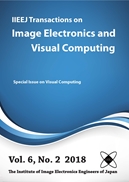Volume 6, Issue 2
IIEEJ Transactions on Image Electronics and Visual Computing
Displaying 1-4 of 4 articles from this issue
- |<
- <
- 1
- >
- >|
IIEEJ_Trans_Vol_06_No_02_2018
-
Article type: Contributed Paper -- Special Issue on Visual Computing --
2018 Volume 6 Issue 2 Pages 56-64
Published: December 15, 2018
Released on J-STAGE: November 29, 2019
Download PDF (2804K) -
Article type: Contributed Paper
2018 Volume 6 Issue 2 Pages 65-73
Published: December 15, 2018
Released on J-STAGE: November 29, 2019
Download PDF (1603K) -
Article type: Contributed Paper
2018 Volume 6 Issue 2 Pages 74-81
Published: December 15, 2018
Released on J-STAGE: November 29, 2019
Download PDF (7038K) -
Article type: Contributed Paper
2018 Volume 6 Issue 2 Pages 82-88
Published: December 15, 2018
Released on J-STAGE: November 29, 2019
Download PDF (3487K)
- |<
- <
- 1
- >
- >|
